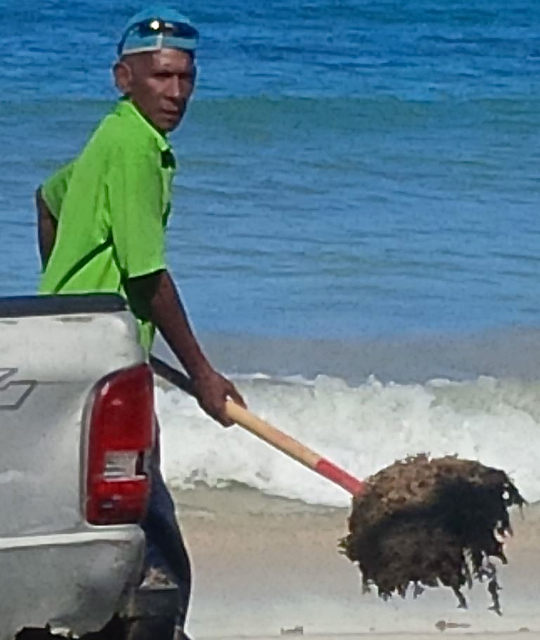
Jamal Nielsen, spokesman at the Department of Planning and Natural Resources, said the issue seems to be impacting north facing beaches the most.
“It’s all over everything,” said Jayne Schaeffer, deputy superintendent at V.I. National Park.
Since winds and current are sending it to the northern beaches, on St. John’s south shore as well as other south-facing beaches around the territory, only the normal-looking seaweed was spotted.
“But I see a little bit in the water,” south shore resident Paula Savel said of the sargassum weed.
Schaeffer said the Trunk Bay lifeguard has been cleaning it up, but the park is leaving it alone on the rest of the beaches.
She said at Hawksnest Beach, the waves are pushing it off the beach and into the mangroves. Both Trunk and Hawksnest Beaches are on the island’s north shore.
On both St. Thomas and St. Croix, dive shop staff said they’ve seen plenty of sargassum weed.
“The last few days,” Nick Jones, a diver at the Cane Bay Dive Shop on St. Croix said.
He said it’s starting to clear up, and is now just on the beach but not in the water.
Steve Chrisman, who works at Dive In at St. Thomas’s Sapphire Beach, said the sargassum weed started arriving two or three weeks ago.
“It’s gotten a little better,” he said.
Nielsen said that before hotels use heavy equipment to clean up the piles of sargassum weed, they should ask Planning for permission. He said that there could be endangered species living in the weeds, and the department wants to make sure they’re not harmed if the hotels use equipment.
According to the park website, sargassum weed serves as home to sargassum shrimp, plan-head filefish, crabs, turtles, and seahorses. The weed is full of nutrients and used for fertilizer, building beach dunes, and even beer.
While sargassum weed has hit the territory several times in recent years, Schaeffer said she understands that this event is the worst.
“The big wave began Sunday or Monday,” she said.
Rafe Boulon, who retired several years ago as the park’s chief of resource management, said it hit “hot and heavy” over the weekend.
He said it’s a periodic occurrence that in most years, hits in the summer.
“It’s a natural substance,” he said of the sargassum weed.
Why the amount of sargassum weed that’s piling up seems larger than normal remains unknown, but Boulon suggested that sewage being pumped overboard by ships at sea are providing nutrients to help it grow.
“And temperatures are rising because of global warming,” Boulon said.
Sargassum was named by the Portuguese sailors who found it in the Sargasso Sea, Wikipedia notes. They named it after a species of rock rose (Helianthemum) that grew in their water wells at home and that was called sargaço in Portuguese.
The park has a slew of information about sargassum online at http://www.nps.gov/viis/naturescience/sargassum.htm
See
https://stthomassource.com/content/news/local-news/2011/08/17/sargassum-weed-hits-vi-beaches


